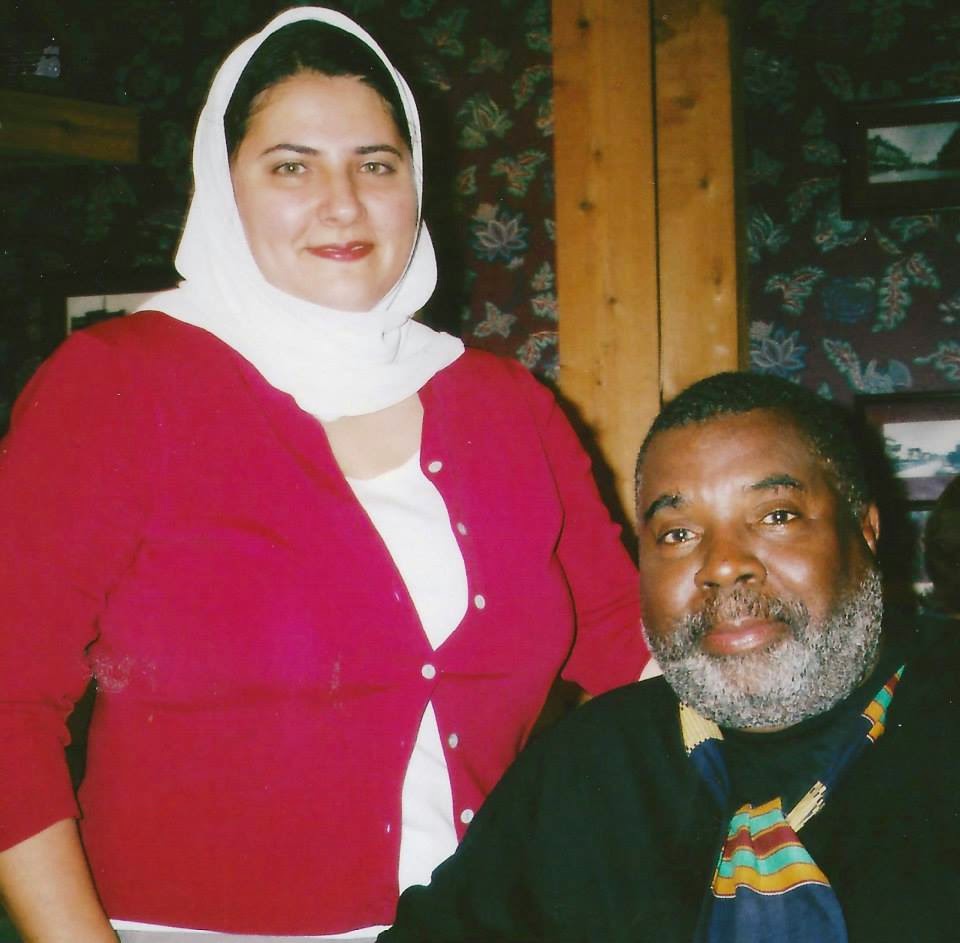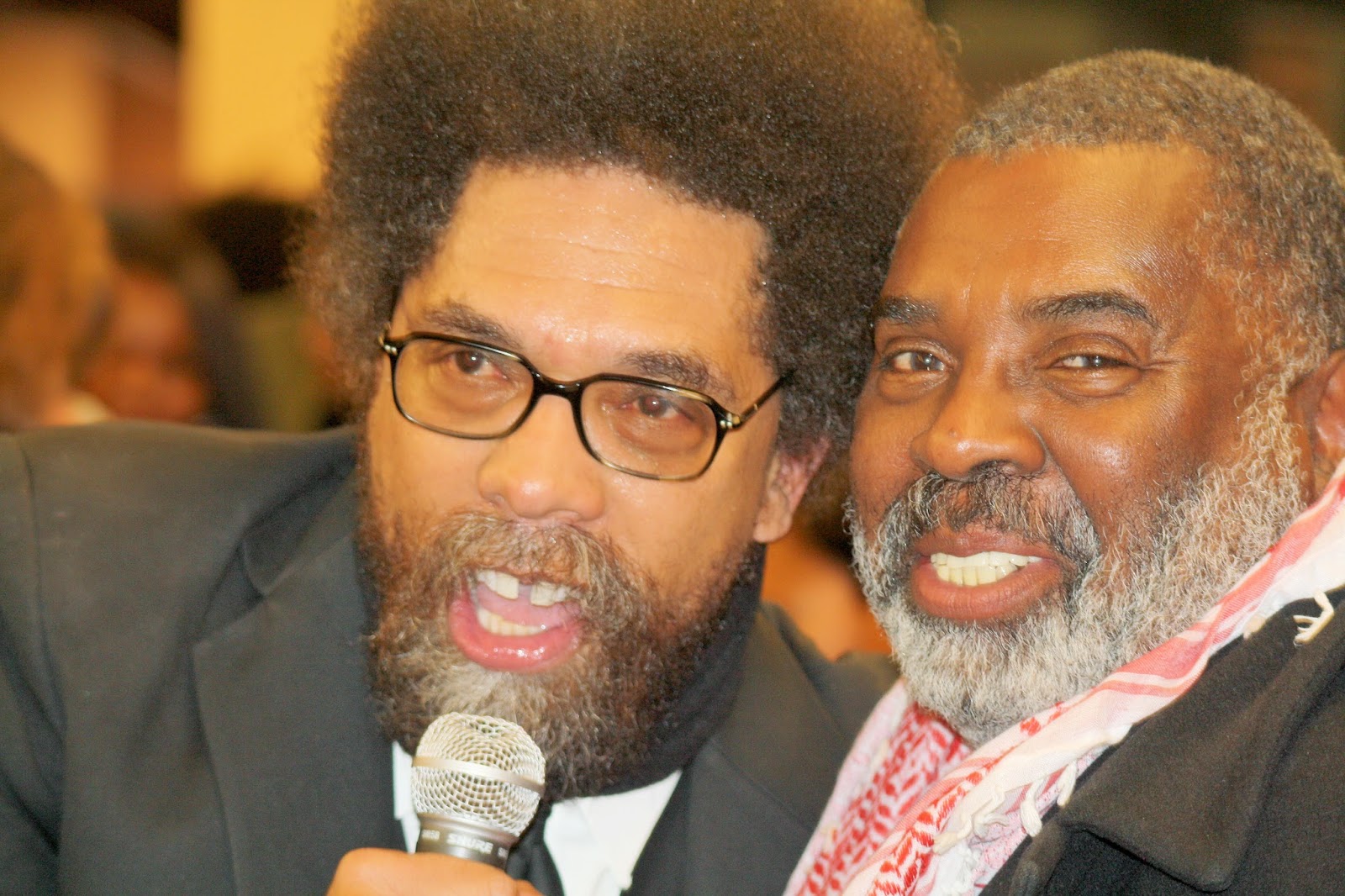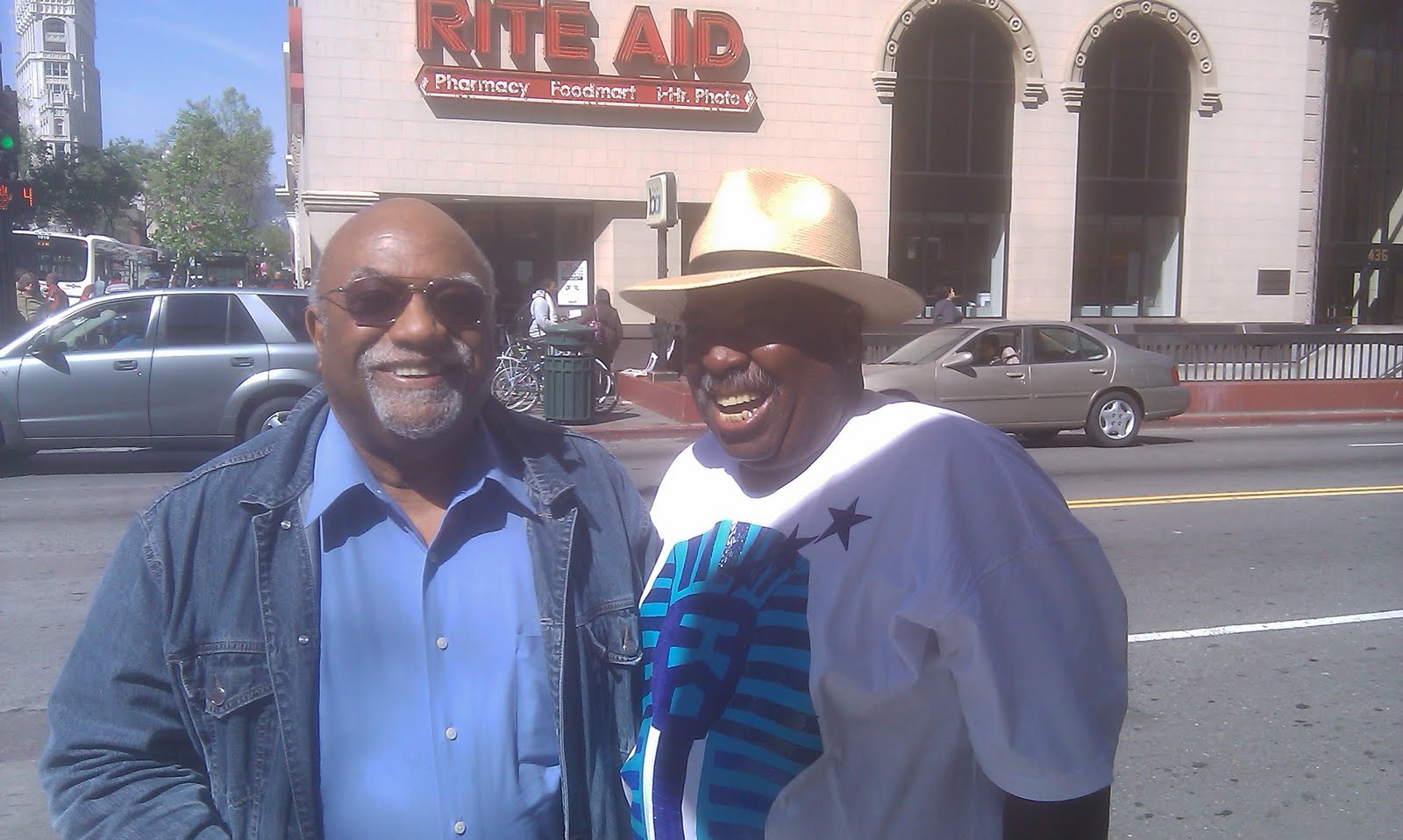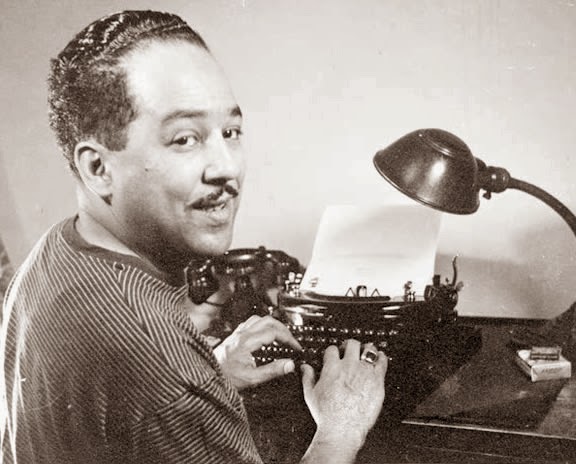Members of the BAM Poet's Choir and Arkestra informed producer Marvin X they are in prayer for the success in acquiring the funding needed for the 27 City Tour prescribed by Ancestor Amiri Baraka. It is estimated the tour will cost $2.7 million dollars @ $100,000.00 per city. Cost of the BAM 50th Anniversary Celebration/Conference at the University of California, Merced, Feb/Mar 2014, was approximately $60,000.00. The Oakland Laney College BAM Celebration, Feb. 7, 2015, was approximately $30,000.00. Marvin X says, "One hundred thousand dollars will allow us to do a first class production, including professional fees for all artists and participants. It will allow us to promote the event in Prime Time.
The Black Arts Movement Poet's Choir and Arkestra at the Malcolm X Jazz/Art Festival, Oakland, May 27, 2014
Adam Turner photo collage
![]() Syrian poet/professor, Dr. Mohja Kahf and Marvin X. She invited Marvin X to speak and read at the University of Arkansas, Fayetteville. Dr. Kahf proclaims that the Black Arts Movement poets are the foundation of the genre Muslim American literature. "Marvin X, well, along with Malcolm X, is the father of Muslim American literature, as well as other BAM poets, including Amiri Baraka, Sonia Sanchez (Laila Mannan), Askia Muhammad Toure', Yusef Rahman, et al.
Syrian poet/professor, Dr. Mohja Kahf and Marvin X. She invited Marvin X to speak and read at the University of Arkansas, Fayetteville. Dr. Kahf proclaims that the Black Arts Movement poets are the foundation of the genre Muslim American literature. "Marvin X, well, along with Malcolm X, is the father of Muslim American literature, as well as other BAM poets, including Amiri Baraka, Sonia Sanchez (Laila Mannan), Askia Muhammad Toure', Yusef Rahman, et al.
Ancestor Ossie Davis, Dr. Nathan Hare, Bobby Seale, Dr. Carlton Goodlet (The street in front of San Francisco City Hall is named after Dr. Carlton Goodlett, publisher of the Sun Reporter Newspaper).
Marvin X in Seattle, Washington at rally protesting genocide in Gaza, occupied Palestine.
Oakland Post Newspaper Publisher Paul Cobb and Marvin X. They are childhood friends who grew up in West Oakland. "Marvin X, is this BAM thing a new Movement?" Paul is a supporter of the BAM District and the BAM 27 City Tour. He has promoted BAM in his Post News Group papers, including the Oakland Post, San Francisco Post, Richmond, Berkeley Post.
Paul Cobb suggests one hundred people in each city donate $100.00 each to BAM 27 City Tour. This will acknowledge that we are serious about doing for self, although we will seek funding from corporations, organizations and governments. We will not compromise our mission as artistic freedom fighters, lovers of truth and beauty. See the following essay by ancestor Langston Hughes:
The Negro Artist and the Racial Mountain (1926)
Earlier that year, Freda Kirchwey, editor of the Nation, mailed Hughes a proof of “The Negro-Art Hokum,” an essay George Schuyler had written for the magazine, requesting a counterstatement. Schuyler, editor of the African-American newspaper The Pittsburgh Courier, questioned in his essay the need for a separate African-American artistic and literary tradition.
Understanding a fellow African American poet’s stated desire to be “a poet—not a Negro poet,” as that poet’s wish to look away from his African American heritage and instead absorb white culture, Hughes’ essay spoke to the concerns of the Harlem Renaissance as it celebrated African American creative innovations such as blues, spirituals, jazz, and literary work that engaged African American life. Notes Hughes, “this is the mountain standing in the way of any true Negro art in America—this urge within the race toward whiteness, the desire to pour racial individuality into the mold of American standardization, and to be as little Negro and as much American as possible.”
His attention to working-class African-American lives, coupled with his refusal to paint these lives as either saintly or stereotypical, brought criticism from several directions. Articulating the unspoken directives he struggled to ignore, Hughes observes, “‘Oh, be respectable, write about nice people, show how good we are,’ say the Negroes. ‘Be stereotyped, don't go too far, don't shatter our illusions about you, don't amuse us too seriously. We will pay you,’ say the whites.”
Hughes’ early poetry often explored domestic and musical themes—particularly jazz—in African American life, and his work grew increasingly political as the Great Depression wore on and his interest in Marxism deepened.
The Black Arts Movement Poet's Choir and Arkestra at the Malcolm X Jazz/Art Festival, Oakland, May 27, 2014
Adam Turner photo collage
Marvin X supports a democratic, non-sectarian Syria, but it is for the Syrian masses to decide their form of government, no matter what form, whether a Sharia or Democratic form of government. It should not be a decision of the imams but the suffering masses.
 Syrian poet/professor, Dr. Mohja Kahf and Marvin X. She invited Marvin X to speak and read at the University of Arkansas, Fayetteville. Dr. Kahf proclaims that the Black Arts Movement poets are the foundation of the genre Muslim American literature. "Marvin X, well, along with Malcolm X, is the father of Muslim American literature, as well as other BAM poets, including Amiri Baraka, Sonia Sanchez (Laila Mannan), Askia Muhammad Toure', Yusef Rahman, et al.
Syrian poet/professor, Dr. Mohja Kahf and Marvin X. She invited Marvin X to speak and read at the University of Arkansas, Fayetteville. Dr. Kahf proclaims that the Black Arts Movement poets are the foundation of the genre Muslim American literature. "Marvin X, well, along with Malcolm X, is the father of Muslim American literature, as well as other BAM poets, including Amiri Baraka, Sonia Sanchez (Laila Mannan), Askia Muhammad Toure', Yusef Rahman, et al. Dr. Cornel West is a longtime supporter of Marvin X and the Black Arts Movement. Dr. West participated in the Marvin X production The Kings and Queens of Black Consciousness, San Francisco State University, April 1, 2001.
Marvin X in Seattle, Washington at rally protesting genocide in Gaza, occupied Palestine.
The Black Arts Movement Poet's Choir and Arkestra, University of California, Merced, 2014
Marvin X, David Murray and Earle Davis, Malcolm X Jazz/Art Fest, Oakland CA 2014
Paul Cobb suggests one hundred people in each city donate $100.00 each to BAM 27 City Tour. This will acknowledge that we are serious about doing for self, although we will seek funding from corporations, organizations and governments. We will not compromise our mission as artistic freedom fighters, lovers of truth and beauty. See the following essay by ancestor Langston Hughes:
The Negro Artist and the Racial Mountain (1926)
Ancestor Paul Robeson, Artistic Freedom Fighter Supreme
Alprentice Bunchy Carter, BAM/Black Power Freedom Fighter, Poet/Chairman of the Los Angeles Chapter of the Black Panther Party.
Kathleen Cleaver, Black Panther Party member, Black Power Revolutionary
Only known picture of Eldridge Cleaver and Marvin X. Marvin X introduced Eldridge Cleaver to Bobby Seale and Huey Newton. Eldridge and Marvin co-founded the San Francisco Black House, 1967, on Broderick Street.
A Day in the life: Marvin X at his Academy of da Corner, renamed the Black Arts Movement District.
Sufi Master, His Holiness Guru Muhaiyadin Bawa, one of Marvin X's main teachers. Many BAM members are influenced by the Sufi Teachers, especially Bamba of Senegal and Sufi Master Hazrat Inayat Khan. Marvin X and the BAM artists are the founders of the genre known as Muslim American literature, according to Dr. Mohja Kahf, University of Arkansas, Fayetteville.
Jah Amiel, grandson of Marvin X. At three years old, he told his grandfather, "Grandfather, you can't save the world, but I can!"
BAM co-founder Amiri Baraka
BAM founding General, Askia Toure'
BAM founding General Sonia Sanchez
BAM founding General Marvin X, West Coast
BAM Generals, Amiri Baraka and Marvin X. They enjoyed a 47 year friendship as Artistic Freedom Fighters.
Mrs. Amina Baraka and Mr. Amiri Baraka, friends of Marvin X for 47 years. I partyed with the Barakas for 47 years, from the time I met them both at the Black House, San Francisco, 1967, founded by Eldridge Cleaver, Ed Bullins, Ethna X. Wyatt (Hurriyah Asar) and myself. I miss my drinking buddy!
Amiri Baraka, "Marvin, why didn't you do it--yeah, the 27 City Tour?"
When AB transitioned, it was the coldest winter ever. --MX
The good times: AB, Amina, Mariam Makeba, Kwame Toure
Marvin X and Nuyorican poet Nancy Mercado at Harlem NY reception for Marvin X.
Introduction
Langston Hughes was a leader of the Harlem Renaissance of the 1920s. He was educated at Columbia University and Lincoln University. While a student at Lincoln, he published his first book of poetry, The Weary Blues (1926), as well as his landmark essay, seen by many as a cornerstone document articulation of the Harlem renaissance, “The Negro Artist and the Racial Mountain.”Earlier that year, Freda Kirchwey, editor of the Nation, mailed Hughes a proof of “The Negro-Art Hokum,” an essay George Schuyler had written for the magazine, requesting a counterstatement. Schuyler, editor of the African-American newspaper The Pittsburgh Courier, questioned in his essay the need for a separate African-American artistic and literary tradition.
Understanding a fellow African American poet’s stated desire to be “a poet—not a Negro poet,” as that poet’s wish to look away from his African American heritage and instead absorb white culture, Hughes’ essay spoke to the concerns of the Harlem Renaissance as it celebrated African American creative innovations such as blues, spirituals, jazz, and literary work that engaged African American life. Notes Hughes, “this is the mountain standing in the way of any true Negro art in America—this urge within the race toward whiteness, the desire to pour racial individuality into the mold of American standardization, and to be as little Negro and as much American as possible.”
His attention to working-class African-American lives, coupled with his refusal to paint these lives as either saintly or stereotypical, brought criticism from several directions. Articulating the unspoken directives he struggled to ignore, Hughes observes, “‘Oh, be respectable, write about nice people, show how good we are,’ say the Negroes. ‘Be stereotyped, don't go too far, don't shatter our illusions about you, don't amuse us too seriously. We will pay you,’ say the whites.”
Hughes’ early poetry often explored domestic and musical themes—particularly jazz—in African American life, and his work grew increasingly political as the Great Depression wore on and his interest in Marxism deepened.
One of the most promising of the young Negro poets said to me once, “I want to be a poet—not a Negro poet,” meaning, I believe, “I want to write like a white poet”; meaning subconsciously, “I would like to be a white poet”; meaning behind that, “I would like to be white.”(1) And I was sorry the young man said that, for no great poet has ever been afraid of being himself. And I doubted then that, with his desire to run away spiritually from his race, this boy would ever be a great poet. But this is the mountain standing in the way of any true Negro art in America—this urge within the race toward whiteness, the desire to pour racial individuality into the mold of American standardization, and to be as little Negro and as much American as possible.
But let us look at the immediate background of this young poet. His family is of what I suppose one would call the Negro middle class: people who are by no means rich yet never uncomfortable nor hungry—smug, contented, respectable folk, members of the Baptist church. The father goes to work every morning.
He is a chief steward at a large white club. The mother sometimes does fancy sewing or supervises parties for the rich families of the town. The children go to a mixed school. In the home they read white papers and magazines. And the mother often says “Don’t be like niggers” when the children are bad.
A frequent phrase from the father is, “Look how well a white man does things.” And so the word white comes to be unconsciously a symbol of all virtues. It holds for the children beauty, morality, and money. The whisper of “I want to be white” runs silently through their minds. This young poet’s home is, I believe, a fairly typical home of the colored middle class. One sees immediately how difficult it would be for an artist born in such a home to interest himself in interpreting the beauty of his own people. He is never taught to see that beauty. He is taught rather not to see it, or if he does, to be ashamed of it when it is not according to Caucasian patterns.
For racial culture the home of a self-styled “high-class” Negro has nothing better to offer. Instead there will perhaps be more aping of things white than in a less cultured or less wealthy home. The father is perhaps a doctor, lawyer, landowner, or politician. The mother may be a social worker, or a teacher, or she may do nothing and have a maid. Father is often dark but he has usually married the lightest woman he could find. The family attend a fashionable church where few really colored faces are to be found. And they themselves draw a color line.
In the North they go to white theaters and white movies. And in the South they have at least two cars and house “like white folks.” Nordic manners, Nordic faces, Nordic hair, Nordic art (if any), and an Episcopal heaven. A very high mountain indeed for the would-be racial artist to climb in order to discover himself and his people.
But then there are the low-down folks, the so-called common element, and they are the majority—may the Lord be praised! The people who have their nip of gin on Saturday nights and are not too important to themselves or the community, or too well fed, or too learned to watch the lazy world go round. They live on Seventh Street in Washington or State Street in Chicago and they do not particularly care whether they are like white folks or anybody else. Their joy runs, bang! into ecstasy. Their religion soars to a shout. Work maybe a little today, rest a little tomorrow. Play awhile. Sing awhile. O, let’s dance!
These common people are not afraid of spirituals, as for a long time their more intellectual brethren were, and jazz is their child. They furnish a wealth of colorful, distinctive material for any artist because they still hold their own individuality in the face of American standardizations. And perhaps these common people will give to the world its truly great Negro artist, the one who is not afraid to be himself. Whereas the better-class Negro would tell the artist what to do, the people at least let him alone when he does appear. And they are not ashamed of him—if they know he exists at all. And they accept what beauty is their own without question.
Certainly there is, for the American Negro artist who canescape the restrictions the more advanced among his own group would put upon him, a great field of unused material ready for his art. Without going outside his race, and even among the better classes with their “white” culture and conscious American manners, but still Negro enough to be different, there is sufficient matter to furnish a black artist with a lifetime of creative work. And when he chooses to touch on the relations between Negroes and whites in this country, with their innumerable overtones and undertones, surely, and especially for literature and the drama, there is an inexhaustible supply of themes at hand. To these the Negro artist can give his racial individuality, his heritage of rhythm and warmth, and his incongruous humor that so often, as in the Blues, becomes ironic laughter mixed with tears. But let us look again at the mountain.
A prominent Negro clubwoman in Philadelphia paid eleven dollars to hear Raquel Meller sing Andalusian popular songs. But she told me a few weeks before she would not think of going to hear “that woman,” Clara Smith, a great black artist, sing Negro folksongs.(2) And many an upper-class Negro church, even now, would not dream of employing a spiritual in its services. The drab melodies in white folks’ hymnbooks are much to be preferred. “We want to worship the Lord correctly and quietly. We don’t believe in ‘shouting.’ Let’s be dull like the Nordics,” they say, in effect.
But let us look at the immediate background of this young poet. His family is of what I suppose one would call the Negro middle class: people who are by no means rich yet never uncomfortable nor hungry—smug, contented, respectable folk, members of the Baptist church. The father goes to work every morning.
He is a chief steward at a large white club. The mother sometimes does fancy sewing or supervises parties for the rich families of the town. The children go to a mixed school. In the home they read white papers and magazines. And the mother often says “Don’t be like niggers” when the children are bad.
A frequent phrase from the father is, “Look how well a white man does things.” And so the word white comes to be unconsciously a symbol of all virtues. It holds for the children beauty, morality, and money. The whisper of “I want to be white” runs silently through their minds. This young poet’s home is, I believe, a fairly typical home of the colored middle class. One sees immediately how difficult it would be for an artist born in such a home to interest himself in interpreting the beauty of his own people. He is never taught to see that beauty. He is taught rather not to see it, or if he does, to be ashamed of it when it is not according to Caucasian patterns.
For racial culture the home of a self-styled “high-class” Negro has nothing better to offer. Instead there will perhaps be more aping of things white than in a less cultured or less wealthy home. The father is perhaps a doctor, lawyer, landowner, or politician. The mother may be a social worker, or a teacher, or she may do nothing and have a maid. Father is often dark but he has usually married the lightest woman he could find. The family attend a fashionable church where few really colored faces are to be found. And they themselves draw a color line.
In the North they go to white theaters and white movies. And in the South they have at least two cars and house “like white folks.” Nordic manners, Nordic faces, Nordic hair, Nordic art (if any), and an Episcopal heaven. A very high mountain indeed for the would-be racial artist to climb in order to discover himself and his people.
But then there are the low-down folks, the so-called common element, and they are the majority—may the Lord be praised! The people who have their nip of gin on Saturday nights and are not too important to themselves or the community, or too well fed, or too learned to watch the lazy world go round. They live on Seventh Street in Washington or State Street in Chicago and they do not particularly care whether they are like white folks or anybody else. Their joy runs, bang! into ecstasy. Their religion soars to a shout. Work maybe a little today, rest a little tomorrow. Play awhile. Sing awhile. O, let’s dance!
These common people are not afraid of spirituals, as for a long time their more intellectual brethren were, and jazz is their child. They furnish a wealth of colorful, distinctive material for any artist because they still hold their own individuality in the face of American standardizations. And perhaps these common people will give to the world its truly great Negro artist, the one who is not afraid to be himself. Whereas the better-class Negro would tell the artist what to do, the people at least let him alone when he does appear. And they are not ashamed of him—if they know he exists at all. And they accept what beauty is their own without question.
Certainly there is, for the American Negro artist who canescape the restrictions the more advanced among his own group would put upon him, a great field of unused material ready for his art. Without going outside his race, and even among the better classes with their “white” culture and conscious American manners, but still Negro enough to be different, there is sufficient matter to furnish a black artist with a lifetime of creative work. And when he chooses to touch on the relations between Negroes and whites in this country, with their innumerable overtones and undertones, surely, and especially for literature and the drama, there is an inexhaustible supply of themes at hand. To these the Negro artist can give his racial individuality, his heritage of rhythm and warmth, and his incongruous humor that so often, as in the Blues, becomes ironic laughter mixed with tears. But let us look again at the mountain.
A prominent Negro clubwoman in Philadelphia paid eleven dollars to hear Raquel Meller sing Andalusian popular songs. But she told me a few weeks before she would not think of going to hear “that woman,” Clara Smith, a great black artist, sing Negro folksongs.(2) And many an upper-class Negro church, even now, would not dream of employing a spiritual in its services. The drab melodies in white folks’ hymnbooks are much to be preferred. “We want to worship the Lord correctly and quietly. We don’t believe in ‘shouting.’ Let’s be dull like the Nordics,” they say, in effect.
Langston Hughes, “The Negro Artist and the Racial Mountain” from TheCollected Works of Langston Hughes, published by University of Missouri Press. Copyright © 2002 by The Estate of Langston Hughes. Reprinted with the permission of Harold Ober Associates Incorporated.































